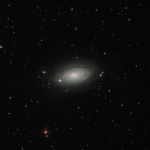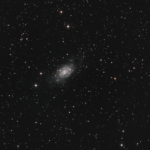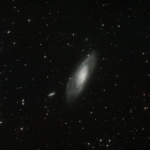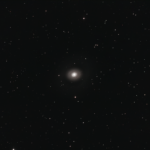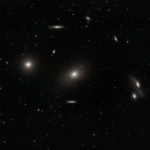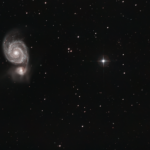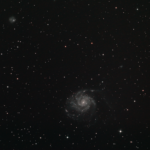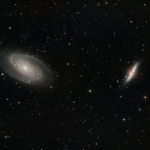NGC 4631 (also known as the Whale Galaxy or Caldwell 32) is a barred spiral galaxy in the constellation Canes Venatici about 30 million light years away from Earth. This galaxy’s slightly distorted wedge shape gives it the appearance of a herring or a whale, hence its nickname. Because this nearby galaxy is seen edge-on…
Sunflower Galaxy (M63)
Messier 63 or M63, also known as NGC 5055 or the seldom-used Sunflower Galaxy, is a spiral galaxy in the northern constellation of Canes Venatici with approximately 400 billion stars. M63 was first discovered by the French astronomer Pierre Méchain, then later verified by his colleague Charles Messieron June 14, 1779. The galaxy became listed as…
NGC 2403
NGC 2403 (also known as Caldwell 7) is an intermediate spiral galaxy in the constellation Camelopardalis. NGC 2403 is an outlying member of the M81 Group, and is approximately 8 million light-years distant. It bears a striking similarity to M33, being about 50,000 light years in diameter and containing numerous star-forming H II regions. The northern spiral arm connects it to the star forming region NGC 2404. NGC 2403…
Fireworks Galaxy (NGC 6946)
NGC 6946 is a face-on intermediate spiral galaxy with a small bright nucleus, whose location in the sky straddles the boundary between the northern constellations of Cepheus and Cygnus. Its distance from Earth is about 22.5 million light-years or 6.8 megaparsecs, similar to the distance of M101 (NGC 5457) in the constellation Ursa Major. Both…
Messier 106
Messier 106 (also known as NGC 4258) is an intermediate spiral galaxy in the constellation Canes Venatici. It was discovered by Pierre Méchain in 1781. M106 is at a distance of about 22 to 25 million light-years away from Earth. M106 contains an active nucleus classified as a Type 2 Seyfert, and the presence of…
Messier 94
Messier 94 (also known as NGC 4736) is a spiral galaxy in the constellation Canes Venatici. It was discovered by Pierre Méchain in 1781, and catalogued by Charles Messier two days later. Although some references describe M94 as a barred spiral galaxy, the “bar” structure appears to be more oval-shaped. The galaxy has two ring structures….
Markarian’s Chain (M86)
Markarian’s Chain is a stretch of galaxies that forms part of the Virgo Cluster. When viewed from Earth, the galaxies lie along a smoothly curved line. Charles Messier first discovered two of the galaxies, M84 and M86, in 1781. The other galaxies seen in the chain were first mentioned in John Louis Emil Dreyer‘s New…
Whirlpool Galaxy (M51)
The Whirlpool Galaxy, also known as Messier 51a, M51a, and NGC 5194, is an interacting grand-design spiral galaxy with a Seyfert 2 active galactic nucleus. It lies in the constellation Canes Venatici, and was the first galaxy to be classified as a spiral galaxy. Its distance is estimated to be between 15 and 35 million light-years….
Pinwheel Galaxy (M101)
The Pinwheel Galaxy (also known as Messier 101, M101 or NGC 5457) is a face-on spiral galaxydistanced 21 million light-years (six megaparsecs) away from earth in the constellation Ursa Major. First discovered by Pierre Méchain on March 27, 1781, it was communicated to Charles Messier who verified its position for inclusion in the Messier Catalogue…
Bode’s Nebula (M81 and M82)
Messier 81 (also known as NGC 3031 or Bode’s Galaxy) is a spiral galaxy about 12 million light-yearsaway in the constellation Ursa Major. Due to its proximity to Earth, large size, and active galactic nucleus(which harbors a 70 million M☉ supermassive black hole), Messier 81 has been studied extensively by professional astronomers. The galaxy’s large…

